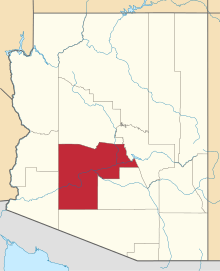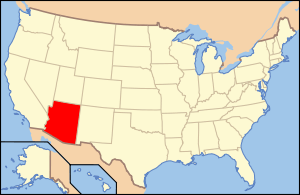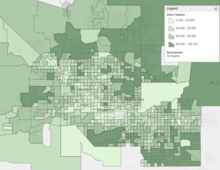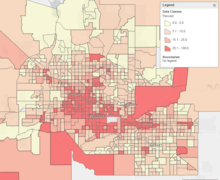Maricopa County, Arizona
| Maricopa County, Arizona | |||
|---|---|---|---|
| County | |||
| County of Maricopa[1] | |||
|
The Maricopa County Courthouse and Old Phoenix City Hall, also known as the County-City Administration Building, in 2013 | |||
| |||
 Location in the U.S. state of Arizona | |||
 Arizona's location in the U.S. | |||
| Founded | February 14, 1871 | ||
| Seat | Phoenix | ||
| Largest city | Phoenix | ||
| Area | |||
| • Total | 9,224 sq mi (23,890 km2) | ||
| • Land | 9,200 sq mi (23,828 km2) | ||
| • Water | 24 sq mi (62 km2), 0.3% | ||
| Population (est.) | |||
| • (2017) | 4,307,033 | ||
| • Density | 468/sq mi (181/km2) | ||
| Congressional districts | 1st, 3rd, 4th, 5th, 6th, 7th, 8th, 9th | ||
| Time zone | Mountain: UTC−7 | ||
| Website |
www | ||
Maricopa County (/ˌmærɪˈkoʊpə/ MARR-i-KOH-pə) is a county in the south-central part of the U.S. state of Arizona. As of the 2010 census, its population was 3,817,117,[2] making it the state's most populous county, and the fourth-most populous in the United States. It is more populous than 23 states. The county seat is Phoenix,[3] the state capital and fifth-most populous city in the country.
Maricopa County is the central county of the Phoenix-Mesa-Glendale, AZ Metropolitan Statistical Area.
Maricopa County was named after the Maricopa Indians.[4] There are five Indian reservations located in the county.[5] The largest are the Salt River Pima-Maricopa Indian Community (east of Scottsdale) and the Gila River Indian Community (south of Chandler).
Geography
According to the U.S. Census Bureau, the county has a total area of 9,224 square miles (23,890 km2), of which 9,200 square miles (24,000 km2) is land and 24 square miles (62 km2) (0.3%) is water.[6] Maricopa County is also one of the largest counties in the United States by area having a land area greater than that of seven states. From west to east, it stretches 132 miles (212 km) and 103 miles (166 km) from north to south.[7] It is by far Arizona's most populous county, encompassing well over half of the state's residents. It is also the largest county in the United States to contain a capital city.
Adjacent counties
- La Paz County – west
- Yuma County – west
- Pima County – south
- Pinal County – southeast
- Gila County – east
- Yavapai County – north
National protected areas
- Sonoran Desert National Monument (part)
- Tonto National Forest (part)
Demographics


| Historical population | |||
|---|---|---|---|
| Census | Pop. | %± | |
| 1880 | 5,689 | — | |
| 1890 | 10,986 | 93.1% | |
| 1900 | 20,457 | 86.2% | |
| 1910 | 34,488 | 68.6% | |
| 1920 | 89,576 | 159.7% | |
| 1930 | 150,970 | 68.5% | |
| 1940 | 186,193 | 23.3% | |
| 1950 | 331,770 | 78.2% | |
| 1960 | 663,510 | 100.0% | |
| 1970 | 971,228 | 46.4% | |
| 1980 | 1,509,175 | 55.4% | |
| 1990 | 2,122,101 | 40.6% | |
| 2000 | 3,072,149 | 44.8% | |
| 2010 | 3,817,117 | 24.2% | |
| Est. 2017 | 4,307,033 | [10] | 12.8% |
| U.S. Decennial Census[11] 1790–1960[12] 1900–1990[13] 1990–2000[14] 2010–2016[2] | |||
2000 census
As of the census of 2000, there were 3,072,149 people, 1,132,886 households, and 763,565 families residing in the county. The population density was 334 people per square mile (129/km²). There were 1,250,231 housing units at an average density of 136/sq mi (52/km²). The racial makeup of the county was 77.4% White, 3.7% African American, 1.9% Native American, 2.2% Asian, 0.1% Pacific Islander, 11.9% from other races, and 2.9% from two or more races. 29.5% of the population were Hispanic or Latino of any race. 19.1% reported speaking Spanish at home.[15]
There were 1,132,886 households out of which 33.0% had children under the age of 18 living with them, 51.6% were married couples living together, 10.7% had a female householder with no husband present, and 32.6% were non-families. 24.5% of all households were made up of individuals and 7.9% had someone living alone who was 65 years of age or older. The average household size was 2.67 and the average family size was 3.21.
The population was spread out with 27.0% under the age of 18, 10.2% from 18 to 24, 31.4% from 25 to 44, 19.80% from 45 to 64, and 11.7% who were 65 years of age or older. The median age was 33 years. For every 100 females, there were 100.10 males. For every 100 females age 18 and over, there were 98.10 males.
The median income for a household in the county was $45,358, and the median income for a family was $51,827. Males had a median income of $36,858 versus $28,703 for females. The per capita income for the county was $22,251. About 8.0% of families and 11.7% of the population were below the poverty line, including 15.4% of those under age 18 and 7.4% of those age 65 or over.
2010 census
As of the 2010 United States Census, there were 3,817,117 people, 1,411,583 households, and 932,814 families residing in the county.[16] The population density was 414.9 inhabitants per square mile (160.2/km2). There were 1,639,279 housing units at an average density of 178.2 per square mile (68.8/km2).[17] The racial makeup of the county was 73.0% white (58.7% non-Hispanic white), 5.0% black or African American, 3.5% Asian, 2.1% American Indian, 0.2% Pacific islander, 12.8% from other races, and 3.5% from two or more races. Those of Hispanic or Latino origin made up 29.6% of the population.[16] The largest ancestry groups were:[18]
Of the 1,411,583 households, 35.1% had children under the age of 18 living with them, 47.8% were married couples living together, 12.4% had a female householder with no husband present, 33.9% were non-families, and 25.9% of all households were made up of individuals. The average household size was 2.67 and the average family size was 3.25. The median age was 34.6 years.[16]
The median income for a household in the county was $55,054 and the median income for a family was $65,438. Males had a median income of $45,799 versus $37,601 for females. The per capita income for the county was $27,816. About 10.0% of families and 13.9% of the population were below the poverty line, including 19.8% of those under age 18 and 7.0% of those age 65 or over.[19]
According to data provided by the United States Census Bureau in October 2015 and collected from 2009-2013, 73.72% of the population aged five years and over spoke only English at home, while 20.32% spoke Spanish, 0.56% spoke Chinese, 0.47% Vietnamese, 0.41% Tagalog, 0.37% Arabic, 0.36% German, 0.30% French, 0.25% Navajo, 0.21% Korean, 0.20% Hindi, 0.15% Italian, 0.14% Persian, 0.13% Russian, 0.13% Serbocroatian, 0.12% Telugu, 0.12% Polish, 0.11% Syriac, 0.11% Japanese, 0.11% spoke Romanian, and 0.10% spoke other Native North American languages at home.[20]
Government, policing, and politics
Government
The governing body of Maricopa County is its Board of Supervisors. The Board of Supervisors consists of five members chosen by popular vote within their own districts. Currently, the Board consists of four Republicans, each representing districts in the more affluent or conservative districts of the county, and one Democrat, representing the largest district. Each member serves a four-year term, with no term limits.
Maricopa County sheriff
The Maricopa County Sheriff's Office provides court protection, administers the county jail, and patrols the unincorporated areas of the county plus incorporated towns by contract.
Politics
Maricopa County has a long history of being a Republican Party stronghold. While the city of Phoenix leans towards the Democratic Party, along with some other small areas within the county, the rest of the county tends to vote heavily Republican. Every Republican presidential candidate has carried Maricopa County since 1948. This includes the 1964 presidential run of native son Barry Goldwater, who would not have even carried his own state had it not been for a 21,000-vote margin in Maricopa County. It is currently the largest county in the country to vote Republican. Since 1964, Democrats have only kept the margin to single digits three times–in 1992, 1996, and 2016.
| Year | Republican | Democratic | Others |
|---|---|---|---|
| 2016 | 47.7% 747,361 | 44.8% 702,907 | 7.5% 117,566 |
| 2012 | 54.3% 749,885 | 43.6% 602,288 | 2.1% 28,786 |
| 2008 | 54.4% 746,448 | 43.9% 602,166 | 1.7% 22,756 |
| 2004 | 56.9% 679,455 | 42.3% 504,849 | 0.9% 10,657 |
| 2000 | 53.2% 479,967 | 42.9% 386,683 | 3.9% 35,049 |
| 1996 | 47.2% 386,015 | 44.5% 363,991 | 8.2% 67,426 |
| 1992 | 41.1% 360,049 | 32.6% 285,457 | 26.4% 231,326 |
| 1988 | 64.9% 442,337 | 33.9% 230,952 | 1.2% 8,229 |
| 1984 | 72.0% 411,902 | 27.1% 154,833 | 1.0% 5,538 |
| 1980 | 65.0% 316,287 | 24.6% 119,752 | 10.4% 50,795 |
| 1976 | 61.7% 258,262 | 34.5% 144,613 | 3.8% 15,966 |
| 1972 | 69.3% 244,593 | 27.0% 95,135 | 3.8% 13,272 |
| 1968 | 59.1% 162,262 | 31.4% 86,204 | 9.5% 26,185 |
| 1964 | 53.9% 143,114 | 46.0% 122,042 | 0.1% 170 |
| 1960 | 59.4% 127,090 | 40.6% 86,834 | 0.1% 135 |
| 1956 | 63.0% 92,140 | 36.9% 54,010 | 0.1% 191 |
| 1952 | 60.6% 77,249 | 39.4% 50,285 | |
| 1948 | 46.3% 36,585 | 51.3% 40,498 | 2.4% 1,909 |
| 1944 | 43.4% 24,853 | 56.2% 32,197 | 0.4% 208 |
| 1940 | 38.9% 22,610 | 60.4% 35,055 | 0.7% 414 |
| 1936 | 28.7% 13,671 | 67.3% 32,031 | 4.0% 1,908 |
| 1932 | 34.1% 15,086 | 64.6% 28,601 | 1.3% 593 |
| 1928 | 62.3% 20,089 | 37.6% 12,146 | 0.1% 34 |
| 1924 | 44.7% 10,611 | 38.6% 9,177 | 16.7% 3,970 |
| 1920 | 56.2% 11,336 | 43.8% 8,825 | |
| 1916 | 39.3% 5,747 | 52.1% 7,634 | 8.6% 1,259 |
| 1912 | 11.3% 642 | 46.0% 2,606 | 42.7% 2,421 |
Despite its apparent political leanings, Maricopa County voted against Proposition 107 in the 2006 election. This referendum, designed to ban gay marriage and restrict domestic partner benefits, was rejected by a 51.6–48.4% margin within the county, and statewide by a similar margin. Two years later, however, a majority of county residents voted to pass the ultimately successful state constitutional amendment banning same-sex marriage.
The County Board of Supervisors consists of five members chosen by popular vote within their own districts. Currently, the Board consists of four Republicans, each representing districts in the more affluent or conservative districts of the county, and one Democrat, representing the largest district.[22] Each member serves a four-year term, with no term limits.
Unlike cities and towns in Arizona, counties are politically and legally subordinate to the state, and do not have charters of their own. The Board of Supervisors acts in the capacity of executive authority for the county within the statutes and powers prescribed by Arizona state law. The state legislature devotes considerable time to local matters, with limited discretion granted to the Board of Supervisors on minor ordinance and revenue collection issues. Chair of the Board is held by one member for a period of one year, and is selected by the Board members themselves through public hearing.
The election of the County Sheriff, County Attorney, County Assessor, County Treasurer, Superintendent of Schools, County Recorder, Constables, Justices of the Peace, Clerk of the Superior Court, and retention of Superior Court Judges are also determined by popular vote.
The county's dominant political figure for over two decades (from 1993 to 2017) was Sheriff Joe Arpaio, who had dubbed himself "America's Toughest Sheriff" and gained national notoriety for his flamboyant and often controversial practices and policies.[23]
As Maricopa County is home to almost 60 percent of the state's population, it dominates Arizona's politics. Eight of the state's nine congressional districts include at least some portion of the county, and five of said districts have their population center located there. Most of the state's most prominent elected officials live in the county, as well.
Elected officials
United States Congress
| District | Name | Party | First elected [lower-alpha 1] | Area(s) represented | |
|---|---|---|---|---|---|
| United States Senate | |||||
| Class I Senator | Jeff Flake | Republican | 2012 | All of state | |
| Class III Senator | Jon Kyl | Republican | 2018 | ||
| United States House of Representatives | |||||
| 1 | Tom O'Halleran | Democratic | 2016 | Gila River Indian Community | |
| 3 | Raul Grijalva | Democratic | 2002 | Avondale, Buckeye, Phoenix | |
| 4 | Paul Gosar | Republican | 2010 | Northern Maricopa County | |
| 5 | Andy Biggs | Republican | 2016 | Mesa, Chandler, Gilbert | |
| 6 | David Schweikert | Republican | 2010 | Phoenix, Scottsdale | |
| 7 | Ruben Gallego | Democratic | 2014 | Phoenix | |
| 8 | Debbie Lesko | Republican | 2018 | West Valley | |
| 9 | Kyrsten Sinema | Democratic | 2012 | Phoenix, South Scottsdale, Tempe | |
- ↑ Due to redistricting in 2002 and again in 2012, many of the Representatives listed were first elected to a district other than the one they currently represent.
Board of Supervisors
| Party | District | Name | First elected | Area(s) represented | |
|---|---|---|---|---|---|
| Republican | District 1 | Denny Barney | 2012 | Chandler, Gilbert, Mesa, Phoenix, Queen Creek, Scottsdale, Sun Lakes, Tempe | |
| Republican | District 2 | Steve Chucri | 2012 | Apache Junction, Carefree, Cave Creek, Fountain Hills, Gilbert, Mesa, Paradise Valley, Phoenix, Scottsdale | |
| Republican | District 3 | Bill Gates | 2016 | Anthem, Desert Hills, New River, Paradise Valley, Phoenix | |
| Republican | District 4 | Clint Hickman | 2014 | Avondale, Aguila, Buckeye, El Mirage, Glendale, Goodyear, New River, Peoria, Sun City, Sun City West, Surprise, Wickenburg, Youngtown | |
| Democratic | District 5 | Steve Gallardo | 2015 | Avondale, Buckeye, Gila Bend, Glendale, Goodyear, Guadalupe, Phoenix, Tolleson | |
Elected county officials
| Party | Office | Name | First elected | Reference | |
|---|---|---|---|---|---|
| Republican | Assessor | Paul D. Petersen | 2014† | [24] | |
| Republican | Clerk of the Superior Court | Chris DeRose | 2018† | [25] | |
| Republican | County Attorney | Bill Montgomery | 2010 | [26] | |
| Democratic | County Recorder | Adrian Fontes | 2016 | [24] | |
| Republican | County School Superintendent | Steve Watson | 2016 | [24] | |
| Democratic | Sheriff | Paul Penzone | 2016 | [24] | |
| Republican | Treasurer | Royce Flora | 2016 | [24] | |
†Member was originally appointed to the office.
Education
- Maricopa County Library District operates the county libraries in Maricopa County.
Transportation
Major highways
Air
The major primary commercial airport of the county is Sky Harbor International Airport (PHX).
Other airports located in the county include:
- Phoenix-Mesa Gateway Airport in Mesa (AZA)
- Scottsdale Municipal Airport in Scottsdale (SCF)
- Deer Valley Airport in Deer Valley Village in Phoenix (DVT)
- Chandler Municipal Airport in Chandler (CHD)
- Phoenix Goodyear Airport in Goodyear (GYR)
- Glendale Municipal Airport in Glendale (GEU)
- Buckeye Municipal Airport in Buckeye (BXK)
- Falcon Field (Arizona) in Mesa (MSC)
- Gila Bend Municipal Airport in Gila Bend (E63)
- Wickenburg Municipal Airport in Wickenburg (E25)
Rail
In terms of freight rail, the Union Pacific Railroad and the Burlington Northern Santa Fe Railroad serve the county.
In terms of passenger rail, greater Phoenix is served by a light rail system. The county has no other passenger rail transport as Amtrak's Sunset Limited, which served Phoenix until June 2, 1996, has its closest stop in Maricopa in neighboring Pinal County. The train connects Maricopa to Tucson, Los Angeles, and New Orleans three times a week. However it does not stop in Phoenix itself.
Communities
Cities
- Avondale
- Buckeye
- Chandler
- El Mirage
- Glendale
- Goodyear
- Litchfield Park
- Mesa
- Peoria (partly in Yavapai County)
- Phoenix (county seat)
- Scottsdale
- Surprise
- Tempe
- Tolleson
Towns
- Carefree
- Cave Creek
- Fountain Hills
- Gila Bend
- Gilbert
- Guadalupe
- Paradise Valley
- Queen Creek (partly in Pinal County)
- Wickenburg (partly in Yavapai County)
- Youngtown
Ghost towns
- Agua Caliente
- Alma
- Angel Camp
- Marinette
- Vulture City
Census-designated places
Unincorporated communities
Indian communities
County population ranking
The population ranking of the following table is based on the 2010 census of Maricopa County.[27][28]
† county seat
| Rank | City/Town/etc. | Population (2010 Census) | Municipal type | Incorporated |
|---|---|---|---|---|
| 1 | Phoenix † | 1,445,632 | City | 1881 |
| 2 | Mesa | 439,041 | City | 1878 (founded) |
| 3 | Chandler | 236,123 | City | 1920 |
| 4 | Glendale | 226,721 | City | 1910 |
| 5 | Scottsdale | 217,385 | City | 1951 |
| 6 | Gilbert | 208,453 | Town | 1920 |
| 7 | Tempe | 161,719 | City | 1894 |
| 8 | Peoria (partially in Yavapai County) | 154,065 | City | 1954 |
| 9 | Surprise | 117,517 | City | 1960 |
| 10 | Avondale | 76,238 | City | 1946 |
| 11 | Goodyear | 65,275 | City | 1946 |
| 12 | Buckeye | 50,876 | City | 1929 |
| 13 | Sun City | 37,499 | CDP | |
| 14 | El Mirage | 31,797 | City | 1951 |
| 15 | Queen Creek (partially in Pinal County) | 26,361 | Town | 1990 |
| 16 | Sun City West | 24,535 | CDP | |
| 17 | Fountain Hills | 22,489 | Town | 1989 |
| 18 | Anthem | 21,700 | CDP | |
| 19 | New River | 14,952 | CDP | |
| 20 | Sun Lakes | 13,975 | CDP | |
| 21 | Paradise Valley | 12,820 | Town | 1961 |
| 22 | Tolleson | 6,545 | City | 1929 |
| 23 | Wickenburg | 6,363 | Town | 1909 |
| 24 | Youngtown | 6,156 | Town | 1960 |
| 25 | Guadalupe | 5,523 | Town | 1975 |
| 26 | Litchfield Park | 5,476 | City | 1987 |
| 27 | Cave Creek | 5,015 | Town | 1986 |
| 28 | Citrus Park | 4,028 | CDP | |
| 29 | Carefree | 3,363 | Town | 1984 |
| 30 | Gila Bend | 1,922 | Town | 1962 |
| 31 | Rio Verde | 1,811 | CDP | |
| 32 | Komatke | 821 | CDP | |
| 33 | Aguila | 798 | CDP | |
| 34 | Wittmann | 763 | CDP | |
| 35 | Maricopa Colony | 709 | CDP | |
| 36 | Gila Crossing | 621 | CDP | |
| 37 | St. Johns | 476 | CDP | |
| 38 | Morristown | 227 | CDP | |
| 39 | Arlington | 194 | CDP | |
| 40 | Theba | 158 | CDP | |
| 41 | Kaka | 141 | CDP | |
| 42 | Wintersburg | 136 | CDP | |
| 43 | Tonopah | 60 | CDP |
See also
References
- ↑ http://search.maricopa.gov/search?entqr=0&ud=1&sort=date%3AD%3AL%3Ad1&output=xml_no_dtd&oe=UTF-8&ie=UTF-8&client=default_frontend&proxystylesheet=default_frontend&site=default_collection&q=%22county%20of%20maricopa%22
- 1 2 "State & County QuickFacts". United States Census Bureau. Archived from the original on July 6, 2011. Retrieved May 18, 2014.
- ↑ "Find a County". National Association of Counties. Retrieved June 7, 2011.
- ↑ Gannett, Henry (1905). The Origin of Certain Place Names in the United States. U.S. Government Printing Office. p. 199.
- ↑ Indian Reservations in the Continental United States, Bureau of Indian Affairs on National Park Service website. Retrieved January 18, 2009.
- ↑ "2010 Census Gazetteer Files". United States Census Bureau. August 23, 2012. Retrieved August 23, 2015.
- ↑ "Quick Facts about Maricopa County". Maricopa County, Ariz. Retrieved June 21, 2018.
- ↑ "INCOME IN THE PAST 12 MONTHS (IN 2016 INFLATION-ADJUSTED DOLLARS)". American Fact Finder. US Census Bureau. Retrieved 2018-03-21.
- ↑ "POVERTY STATUS IN THE PAST 12 MONTHS". American Fact Finder. US Census Bureau. Retrieved 2018-03-21.
- ↑ "American FactFinder". Retrieved March 23, 2018.
- ↑ "U.S. Decennial Census". United States Census Bureau. Retrieved May 18, 2014.
- ↑ "Historical Census Browser". University of Virginia Library. Retrieved May 18, 2014.
- ↑ "Population of Counties by Decennial Census: 1900 to 1990". United States Census Bureau. Retrieved May 18, 2014.
- ↑ "Census 2000 PHC-T-4. Ranking Tables for Counties: 1990 and 2000" (PDF). United States Census Bureau. Retrieved May 18, 2014.
- ↑ mla.org
- 1 2 3 "DP-1 Profile of General Population and Housing Characteristics: 2010 Demographic Profile Data". United States Census Bureau. Retrieved January 20, 2016.
- ↑ "Population, Housing Units, Area, and Density: 2010 – County". United States Census Bureau. Retrieved January 20, 2016.
- ↑ "DP02 Selected Social Characteristics in the United States – 2006–2010 American Community Survey 5-Year Estimates". United States Census Bureau. Retrieved January 20, 2016.
- ↑ "DP03 Selected Economic Characteristics – 2006–2010 American Community Survey 5-Year Estimates". United States Census Bureau. Retrieved January 20, 2016.
- ↑ "Table 2. Detailed Languages Spoken at Home and Ability to Speak English for the Population 5 Years and Over for Maricopa County, AZ: 2009-2013". United States Census Bureau. Retrieved February 27, 2018.
- ↑ Leip, David. "Dave Leip's Atlas of U.S. Presidential Elections". uselectionatlas.org. Retrieved 2018-06-12.
- ↑ Maricopa County Board of Supervisors, Maricopa County, 2012. Retrieved June 4, 2012.
- ↑ Joseph M. Arpaio Archived June 12, 2010, at the Wayback Machine., Maricopa County Sheriff's Office, 2005. Retrieved December 12, 2007.
- 1 2 3 4 5 http://recorder.maricopa.gov/electionarchives/2012/11-06-2012%20Final%20Summary%20Report.pdf
- ↑ "Clerk of the Superior Court of Maricopa County". www.clerkofcourt.maricopa.gov. Retrieved 2018-03-23.
- ↑ http://recorder.maricopa.gov/electionarchives/2010/11-02-2010%20Final%20Summary%20Report.pdf
- ↑ https://www.census.gov/2010census/
- ↑ https://www.census.gov/geo/maps-data/maps/block/2010/
Further reading
- Maricopa County Sheriff's Office, Maricopa County Sheriff's Office History and Pictorial. Paducah, KY: Turner Publishing. Co., 2005.
External links
| Wikimedia Commons has media related to Maricopa County, Arizona. |
- Official website

- Maricopa County Chamber of Commerce
Coordinates: 33°30′50″N 112°28′33″W / 33.51389°N 112.47583°W


